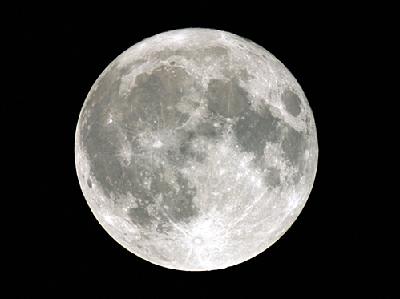|
Full moon is a lunar phase, in which the hemisphere of the moon facing the earth is fully illuminated by the sun and appears round. A full moon occurs when the geocentric apparent longitudes of the sun and the moon differ by 180 degrees. As the full moon corresponds to an age of about 14.8 days of the synodic month, a night with a full moon is called “Jugoya (the 15th night)” in Japanese.
The appearance of the illuminated portion of the moon as seen by an observer on the earth is called luner phases. The phases designate both the degree to which the moon is illuminated and the geometric appearance of the illuminated part. The moon appears as a new moon when the sun and the moon are on the same sides of the earth, while as a full moon when they are on the opposite side. Between the new moon and the full moon, it appears as the first quarter moon and the last quarter moon, which mean we can see half of the illuminated part. If the moon happens to align exactly with the earth and sun, then we get a lunar eclipse.
As a lunar month is about 29.531 days long, the full moon falls on around the 15th day of the lunar month in the calendars that start the month on the new moon such as Chinese Calendar. However, as there is a margin of error, a full moon does not always occur on the 15th day.
The moon on the 15th day of the 8th lunar month of the lunar calendar (usually around mid- or late-September in the Gregorian calendar), when the moon is at its fullest and brightest, is called “Chushu-no-meigetsu (the fine moon in the mid-autumn)” and people hold the Moon Festival. The full moon seems to symbolize the mysterious beauty and power of the moon.
The appearance of the illuminated portion of the moon as seen by an observer on the earth is called luner phases. The phases designate both the degree to which the moon is illuminated and the geometric appearance of the illuminated part. The moon appears as a new moon when the sun and the moon are on the same sides of the earth, while as a full moon when they are on the opposite side. Between the new moon and the full moon, it appears as the first quarter moon and the last quarter moon, which mean we can see half of the illuminated part. If the moon happens to align exactly with the earth and sun, then we get a lunar eclipse.
As a lunar month is about 29.531 days long, the full moon falls on around the 15th day of the lunar month in the calendars that start the month on the new moon such as Chinese Calendar. However, as there is a margin of error, a full moon does not always occur on the 15th day.
The moon on the 15th day of the 8th lunar month of the lunar calendar (usually around mid- or late-September in the Gregorian calendar), when the moon is at its fullest and brightest, is called “Chushu-no-meigetsu (the fine moon in the mid-autumn)” and people hold the Moon Festival. The full moon seems to symbolize the mysterious beauty and power of the moon.
| [+ADDRESS] | 
|












